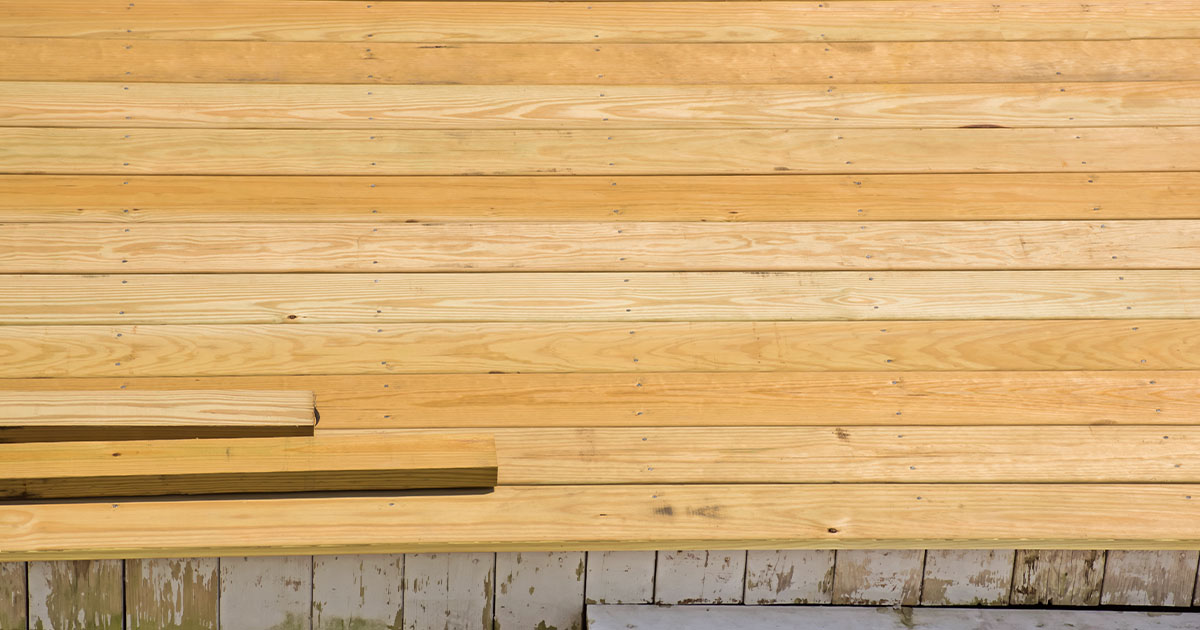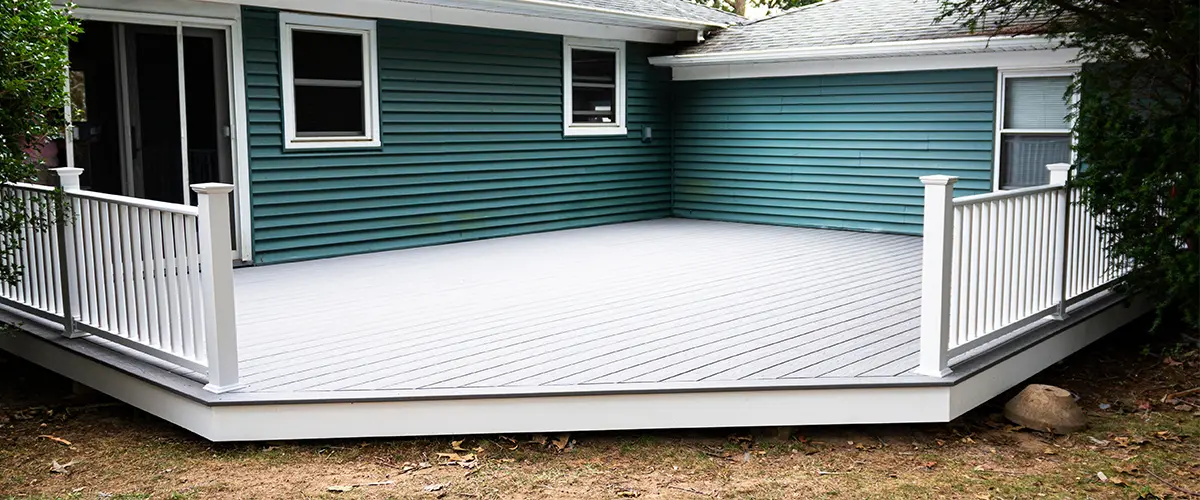If you’re considering building a pressure-treated lumber deck or a cedar wood deck, you might be wondering which option is better, especially for the freezing cold winters and dry summers in Omaha.
While both are popular options, each has its own pros and cons.
Below, we’ll compare the cost, durability, maintenance needs, appearance, lifespan, and installation difficulty of cedar and PT wood to help you make an informed decision for y our deck building project.
Let’s dive right in.

Cedar Decking vs Pressure-Treated Wood
First, let’s ensure you understand both of these wood materials.
- Cedar wood is a fragrant and durable softwood known for its reddish-brown color, resistance to decay, and insect-repellent properties.
- Pressure-treated pine is Douglas Fir (or Southern Pine), chemically treated with preservatives for increased resistance to decay and insects. It’s commonly used for outdoor furniture, fences, decks, pergolas, and more.
Appearance
- Cedar decking boasts a natural beauty with rich, warm tones that pressure-treated wood can’t quite match. Its distinct grain and soft red hues give off an elegant vibe right from installation, gradually weathering into a silvery-gray patina that many homeowners find attractive.
- Pressure-treated lumber, on the other hand, starts as a greenish color due to its chemical treatment process and may require staining or painting for aesthetic appeal.
Cost
Cost plays a significant role in choosing the right decking material for your home.
- Pressure-treated wood is generally more affordable than cedar, making it an attractive option if you have a tight budget. The chemicals used to treat the lumber help resist rot and pests, which means less expense over time on deck repair.
- Cedar’s natural resistance to decay and insects makes it long-lasting; however, this higher-quality wood typically comes with a bigger price tag per square foot. While cedar may require a higher upfront cost, its durability can lead to fewer repairs down the road.
Upkeep
- Cedar decking demands regular maintenance to sustain its rich look and resist the elements in Omaha’s varied climate. Homeowners should anticipate staining or sealing their cedar decks every two to three years.
- Similarly, pressure-treated wood needs just as much upkeep as cedar. In fact, any type of wood, whether a softwood or a hardwood, will require regular sealing, staining, and repairs.
Durability
- Pressure-treated wood boasts a notable resistance to decay and insects that stem from the chemical preservatives used during the treatment process. This type of wood holds up well for decades with proper maintenance.
- Cedar decking offers natural resilience to rot and infestation, thanks to the oils within this softwood species. Although cedar is tough against the elements, it is softer than pressure-treated lumber and may show wear from heavy foot traffic or furniture over time.
Installation
- Installing cedar decking can be more straightforward than working with pressure-treated wood because it’s a lightweight wood and easier to handle. Cedar boards cut cleanly and are less prone to splitting, making a smoother installation.
- For pressure-treated wood decks, taking safety precautions during installation is crucial due to the chemicals used in the treatment process. This type of lumber requires special fasteners that resist corrosion from treated wood.
Either option you choose, you’ll want to pre-drill holes for screws, though, as both cedar and pressure-treated wood are soft and can crack if not handled correctly. After installation, both of these options will need to be sealed or stained once they’re dry. Your contractor will let you know precisely how and when to do it.
A cedar or PT wood is not like a cedar of pressure-treated fence. These structures need to be completely safe as your whole family will spend time there. That being said, it’s best you build your deck with a professional.
Life Span
- Cedar decking is naturally resistant to decay, often serving homeowners well for 15 to 30 years with proper care. Its longevity comes from the wood’s inherent oils that repel insects and resist rotting.
- Similarly, the lifespan of pressure-treated wood can reach up to 30 years if properly taken care of. Its chemical treatment is designed to fend off mold, insects, and rot, but they don’t grant permanent immunity from Omaha’s blistering summers and frigid winters.
Life span greatly hinges on maintenance habits, and we’ve seen both cedar and PT wood last for over 40 years with proper maintenance.
So, while each choice offers different advantages in durability, both demand attention over time to provide a lasting and beautiful outdoor space.
Environmental Impact
- Pressure-treated wood often raises concerns due to the chemicals used in its treatment process. These preservatives can leach into the soil and water, posing environmental risks over time.
- Homeowners looking for more eco-friendly options might lean towards cedar lumber, as it’s a sustainable choice. Western Red Cedar grows faster than many hardwoods and requires less energy to process.
Like pressure-treated wood, responsible sourcing of cedar is crucial; it ensures that forests remain intact and biodiversity is preserved.

3 Other Alternatives For Your Deck In Omaha
If cedar decking or pressure-treated wood doesn’t match your vision for a perfect deck, Omaha homeowners have other materials to consider. These alternatives offer unique benefits and can be tailored to fit different styles and preferences.
- Composite Decking: This modern option is made from a blend of wood fibers and plastic. It requires minimal maintenance, resisting rot, insects, and moisture. The initial cost is higher than traditional wood options but the longevity and low upkeep might save you money over time. Its wide variety of colors and finishes allows for personalized design choices that mimic natural wood or make a bold statement.
- Aluminum Decking: For those looking for durability and strength, aluminum decking is a top contender. This material won’t crack, warp, or splinter over time. It’s also fireproof, making it an excellent choice for safety-conscious homeowners. While the metallic look might not be everyone’s taste, aluminum’s cool-to-the-touch surface is ideal for hot Omaha summers.
- PVC (Polyvinyl Chloride) Decking: If you seek a lightweight yet sturdy alternative, consider PVC decking materials. They resist stains and fading much better than traditional woods and don’t require the same level of constant care. Like composite decking, PVC comes in various colors; however, it boasts even better moisture resistance — an attractive feature in areas with unpredictable weather like Omaha.

Conclusion
Both pressure-treated and cedar wood decks are beautiful, but they require constant maintenance to maximize their lifespan.
Their main difference is the cost (pressure-treated lumber is the cheapest) and the fact that one is treated with preservatives and the other is not.
If you’re not a fan of the maintenance that comes with a wood deck, there’s always composite decking, which requires no sealing, staining, or repairs.
Regardless of what material you want your deck built, what’s more important is who builds it. Here at Deck Bros, we have a reputation for being the best deck builder in Omaha, and if you want to enjoy a quality, safe, and nice deck for a long time, check out our deck-building page!
